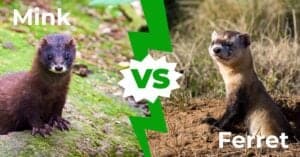Mink and muskrat are two creatures that often live side by side (although one of them definitely gets the short end of the stick in this arrangement) and could easily be confused with one another. Let’s take a look at both of these creatures to discover all we can about them. Additionally, we are going to compare them head to head and see what truly makes them different in an ultimate Mink Vs. Muskrat showdown.
The Main Differences Between A Mink and A Muskrat
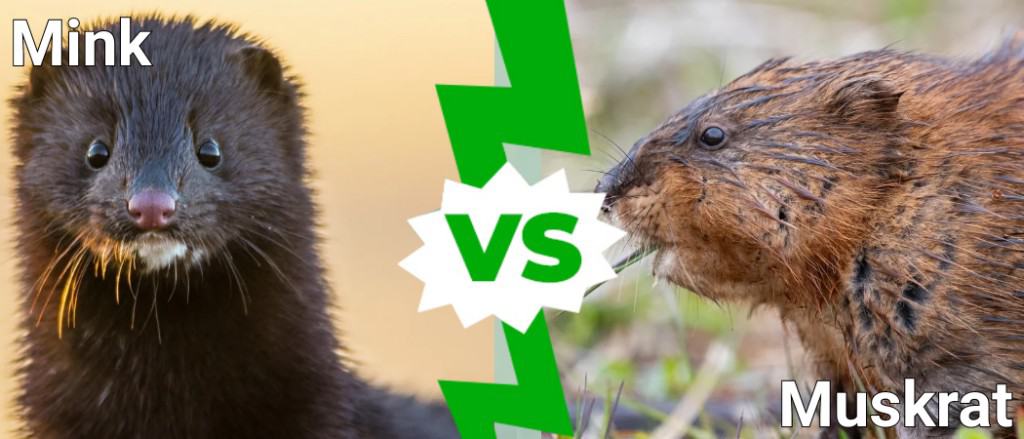
The main differences between a mink and a muskrat are in looks, size, diet, and social behavior. Typically, minks have slender bodies, whereas muskrats are plump and paunchy. Besides, minks are carnivores, feeding on small aquatic and terrestrial animals whereas muskrats are vegetarians. And lastly, while minks are solitary animals, muskrats prefer to stay together as a family.
Now that we’ve established the main differences between a mink and a muskrat, let’s examine their general in detail.
Mink Vs Muskrat: Looks and Size

Mink are weasel-like animals while muskrats more resemble a small beaver.
©An inspiration/Shutterstock.com
Mink are weasel-like creatures with long bodies and short legs. They come in a variety of colors, although their standard is brown to black. Their fur is incredibly thick and soft, one of the main reasons they are farmed and hunted to such an extent across the world. They don’t often weigh more than 3 lbs, but “farmed” individuals will sometimes reach as much as 7 lbs. Their glossy coat and lithe bodies give them a luxurious look. On average, they live for 3 years in the wild.
Muskrat are significantly less aesthetic than mink are, especially as members of the rodent family. They average between 1-4 lbs and are covered in thick, short fur. Their fur is brown to dark brown, and they often resemble a miniature beaver, although their tails are more rat-like than the flat shape of a beaver.
Both animals are semi-aquatic and have dense fur coats that enable them to thrive in such environments. They are also both similarly sized, although the mink is much more athletic and serpentine in appearance, whereas the muskrat is fat and bulky.
Mink Vs Muskrat: Range and Habitat
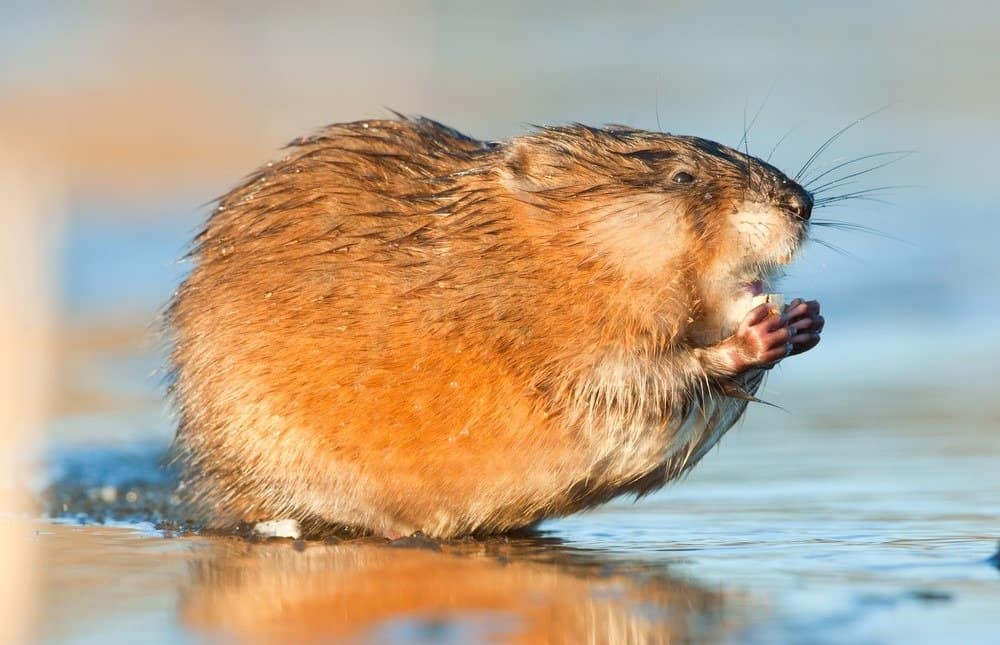
Mink and muskrat share similar ranges and habitats across the world.
©Sergey Uryadnikov/Shutterstock.com
There are two species of mink (and a third extinct), the American mink and the European mink. American mink have some presence in every single US state save for Arizona and are extremely prevalent. European mink had a large historical range, but generations of hunting have reduced their range to small populations in Spain, France, Ukraine, and a few other places. Their largest populations are found in Russia, where the land allows them to live free of humans. Mink prefer habitats near water as they are semi-aquatic animals. Streams, rivers, lakes, and ponds are all likely spots for mink. Some species of mink will roam seashores, but it isn’t as common since they prefer freshwater.
Muskrats are also semi-aquatic animals that live across most of the United States and into Canada and Mexico. Endemic to North America, they were released into Europe to boost the fur industry but soon overpowered the local ecosystems and are now considered invasive. One subspecies lives exclusively in Florida and is known as the round-tailed muskrat or the Florida water rat. Both species prefer vegetation-rich wetlands like swamps, rivers, streams, marshes, and even canals.
Both the muskrat and mink live in similar environments and share a similar range. In fact, their closeness isn’t by chance, as the mink preys on the muskrat as one of its primary food sources.
Mink Vs Muskrat: Diet
Mink are carnivores that prey mostly on small mammals. Additionally, they are known to eat crayfish, snakes, frogs, fish, birds, and eggs. In places where their territories overlap, mink are well known for tracking and eating muskrat. Even though the muskrat is often larger than the mink, the hunting prowess and intelligence of the mink far surpass that of the muskrat. Muskrat is one of the primary food sources for mink in many environments, and they make up an important element of the ecological system.
Muskrats are vegetarians that eat mostly aquatic vegetation. Cattails, water lilies, and watercress are common food sources for the muskrat. In many places, muskrat keep vegetation from encroaching too far into wetland ecosystems. Additionally, muskrat are a foundational prey species for many predators, of which the mink is one. Raccoons, birds of prey, foxes, and more all consider the muskrat an essential part of their diets.
Mink are carnivores that prey on all sorts of animals, namely, the muskrat. Muskrats, however, are used to being preyed on as a foundational prey species in many of the ecosystems they find themselves in.
Mink Vs Muskrat: Social Behavior
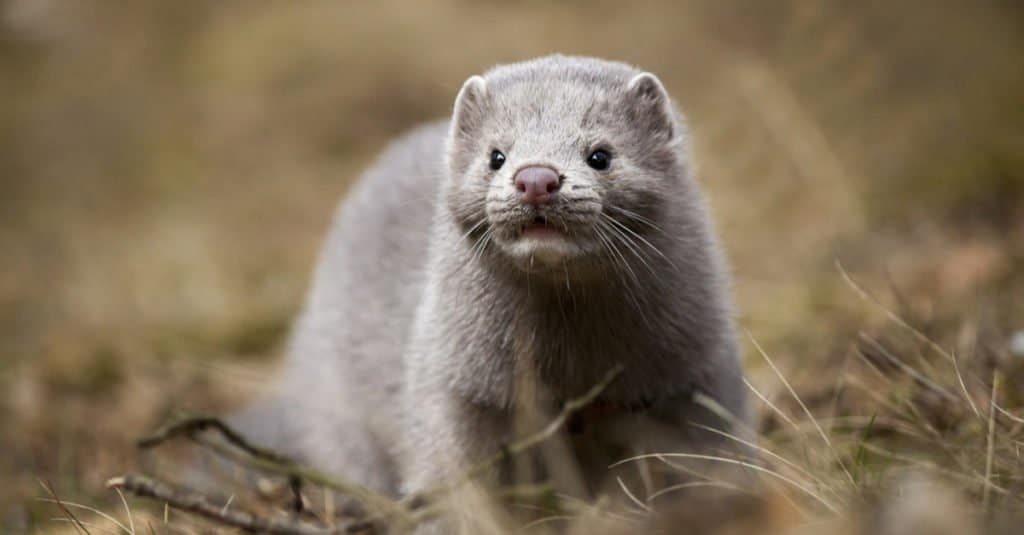
Mink are solitary animals that only congregate to mate. Muskrats gather in family groups in a communal den.
©Aleksandra Saveljeva/Shutterstock.com
Mink are generally solitary creatures. Their entire family, Mustelidae, in fact, are known for being solitary. A mink will travel around wetland and water-side ecosystems, hunting and eating as it goes. The only real moments that a mink heavily engages with other mink are when they breed or raise young. Additionally, mink are highly territorial and will fight (mostly between males) when intruded upon. Mink territory is broken into two areas, one area that has lots of fish and aquatic resources, and another area that has a large rabbit population.
Muskrat generally live in family groups that include a matin pair and their young. The muskrat will build large nests to home their families and will defend their territory from other muskrats fiercely, often to the death. They breed incredibly fast, with females having 2-3 litters a year, each with up to 8 young.
Mink are primarily solitary animals, while muskrats reside in family groups.
Mink Vs Muskrat: Uses in the Fur Industry
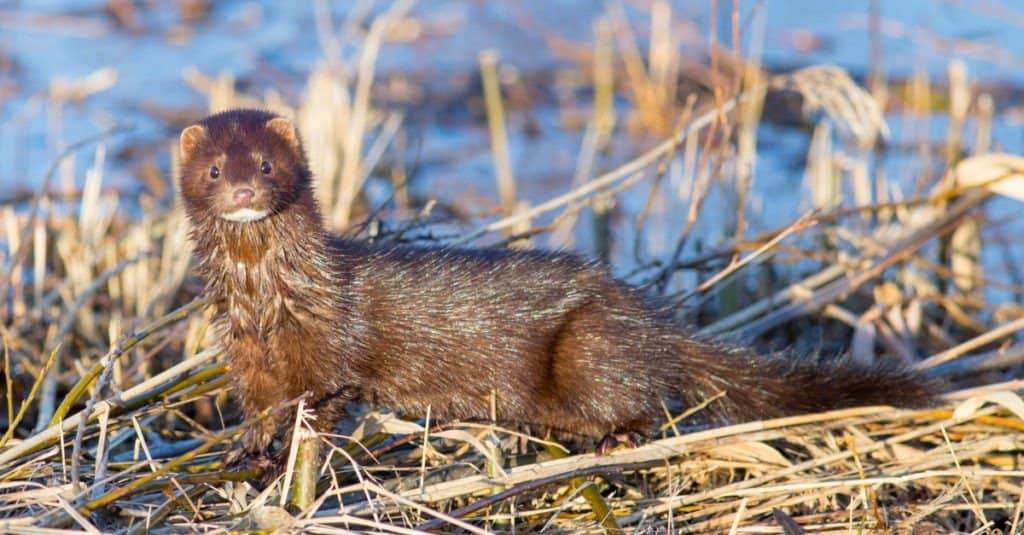
Both species have been used extensively in the fur industry, with mink fur being more prized among the two.
©shauttra/Shutterstock.com
Mink pelts have been a staple in the fur industry for hundreds of years. American mink fur is prized for its quality and luxury, well above that of the European mink. Historically, mink were heavily targeted by trappers and in many places were nearly killed off. Now, most of the fur on the market comes from mink farms across the world. Additionally, mink farms have been a regular target for animal rights groups who have protested the conditions and even released the animals into the wild.
Muskrat have also been a staple animal in the fur industry for quite some time. Although not as commercially desired, muskrat fur is short, strong, and very soft. Muskrat are also prevalent enough in the world that their numbers aren’t threatened by wild farming for their pelts.
Overall, mink pelts are more valuable and produce a better end product. Mink fur is softer, lighter, and more consistent in its texture. Still, muskrat is a reliable fur that has been used by native and colonial peoples for generations. In some places, muskrat fur coats are referred to as a “Hudson Seal” coat.
Up Next…
The photo featured at the top of this post is © Aleksandra Saveljeva/Shutterstock.com
Thank you for reading! Have some feedback for us? Contact the AZ Animals editorial team.




